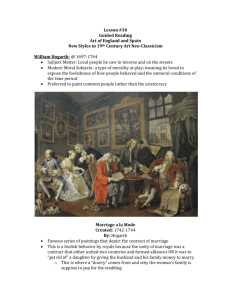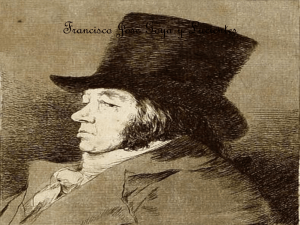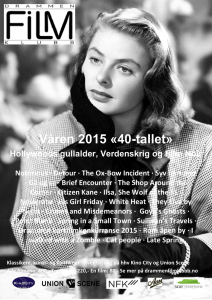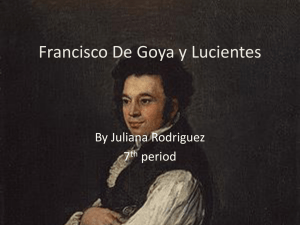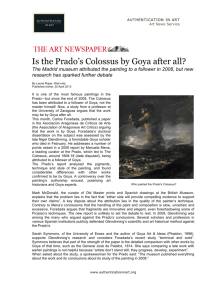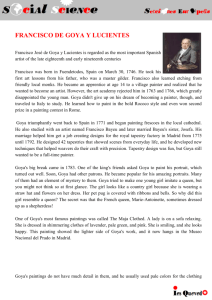Francisco Goya
advertisement
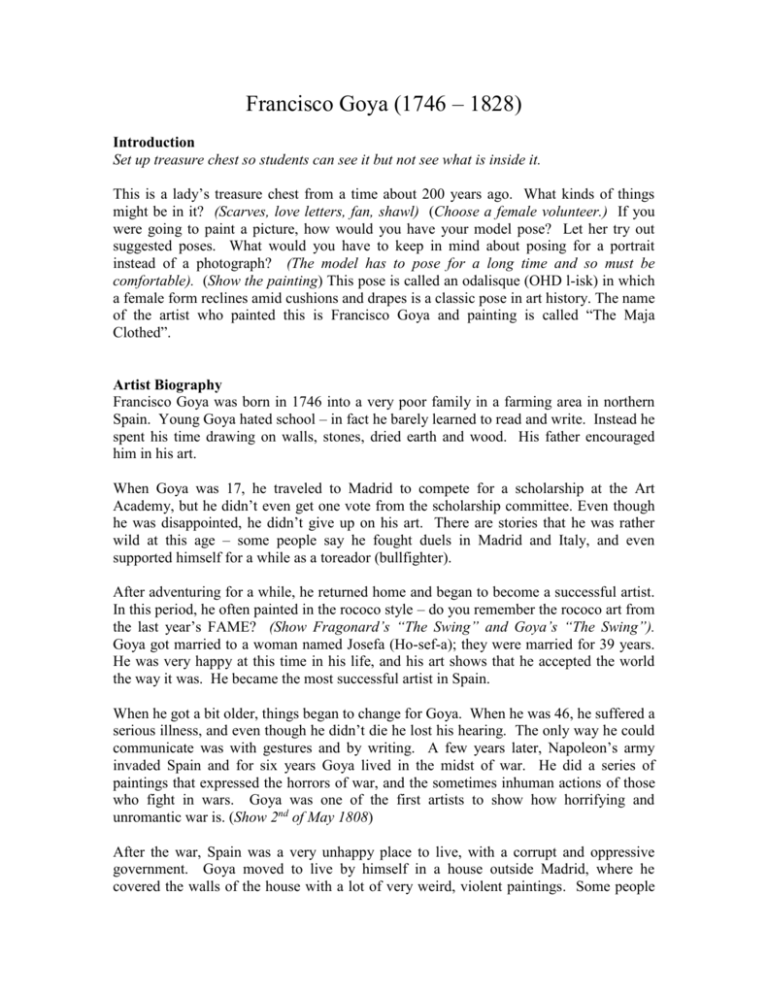
Francisco Goya (1746 – 1828) Introduction Set up treasure chest so students can see it but not see what is inside it. This is a lady’s treasure chest from a time about 200 years ago. What kinds of things might be in it? (Scarves, love letters, fan, shawl) (Choose a female volunteer.) If you were going to paint a picture, how would you have your model pose? Let her try out suggested poses. What would you have to keep in mind about posing for a portrait instead of a photograph? (The model has to pose for a long time and so must be comfortable). (Show the painting) This pose is called an odalisque (OHD l-isk) in which a female form reclines amid cushions and drapes is a classic pose in art history. The name of the artist who painted this is Francisco Goya and painting is called “The Maja Clothed”. Artist Biography Francisco Goya was born in 1746 into a very poor family in a farming area in northern Spain. Young Goya hated school – in fact he barely learned to read and write. Instead he spent his time drawing on walls, stones, dried earth and wood. His father encouraged him in his art. When Goya was 17, he traveled to Madrid to compete for a scholarship at the Art Academy, but he didn’t even get one vote from the scholarship committee. Even though he was disappointed, he didn’t give up on his art. There are stories that he was rather wild at this age – some people say he fought duels in Madrid and Italy, and even supported himself for a while as a toreador (bullfighter). After adventuring for a while, he returned home and began to become a successful artist. In this period, he often painted in the rococo style – do you remember the rococo art from the last year’s FAME? (Show Fragonard’s “The Swing” and Goya’s “The Swing”). Goya got married to a woman named Josefa (Ho-sef-a); they were married for 39 years. He was very happy at this time in his life, and his art shows that he accepted the world the way it was. He became the most successful artist in Spain. When he got a bit older, things began to change for Goya. When he was 46, he suffered a serious illness, and even though he didn’t die he lost his hearing. The only way he could communicate was with gestures and by writing. A few years later, Napoleon’s army invaded Spain and for six years Goya lived in the midst of war. He did a series of paintings that expressed the horrors of war, and the sometimes inhuman actions of those who fight in wars. Goya was one of the first artists to show how horrifying and unromantic war is. (Show 2nd of May 1808) After the war, Spain was a very unhappy place to live, with a corrupt and oppressive government. Goya moved to live by himself in a house outside Madrid, where he covered the walls of the house with a lot of very weird, violent paintings. Some people speculate that being able to express himself through his art was the only thing that kept Goya from going insane. Nevertheless he was very bitter and unhappy man at this time and again his art shows his feelings. (Show self-portrait) Four years before he died, Goya moved to Paris, and finally died alone there at the age of 82. He is known as the “Father of Modern Art”, in part because he used his art to express very deep thoughts and feelings. The Painting The painting for today, “The Maja (Ma-ha) Clothed” is one of Goya’s most famous paintings. The term “maja” referred to the smartly dressed women on Madrid’s streets. The fashions they wore were considered outrageous and were not worn by the majority of society. In fact the maja was in questionable taste in society’s order. The maja’s male counterpart was the “majo” (MA-ho) men who were the fashionable toughs who set themselves above society. In approximately 1795, Goya had a relationship with a very famous patron of his the Duchess of Alba. Though Goya or the Duchess never spoke of it, many were convinced that the model for the painting and its unclothed counterpart (The Maja Nude) was the Duchess herself. In one of Goya’s painting of the Duchess of Alba she wears a ring that has “Goya Only” imprinted on it and she points to Goya’s name written in the sand at her feet. (Show the painting of the Duchess of Alba) Although many artists have done models in the Odalisque pose in Spain where Goya lived people thought this kind of pose was indecent particularly for a woman from high society. So these two “maja” paintings caused a major scandal at that time and for years to come among the Duchess’s descendents. In fact in an attempt to escape the “disgrace” they felt to be upon the family name, they performed a rather bizarre act. In 1945 more than 100 years after the death of the Duchess, her family had her body exhumed. They then compared the measurements of her skeletoned body with those in the painting. Some said it was indeed the Duchess while others maintained the figure in the painting was too small to have been her. So the results were inconclusive and the debate still raged. This painting demonstrates marvelous strength in all the elements of composition. (Show elements of composition) The light, shadow and color intensify the quality of the fabrics and woman’s hair and skin seem to make them glow. Because of its, visually tactile lushness we choose to focus of texture. What textures can you see, and what do you think they would feel like? (Silky clothing, rough lace, soft fur, stiff slippers) Texture Activity: Have one child at a time close their eyes and choose an item from the bag and describe the texture of each item. The bag has fur, lace, orange peel and leather.
